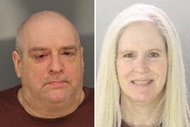Create a free profile to get unlimited access to exclusive videos, breaking news, sweepstakes, and more!
The Strange Dream Confessions At The Center Of Netflix's ‘The Innocent Man’
Although Tommy Ward confessed to kidnapping, raping and killing Donna Denice Haraway, he later retracted it as a false statement — one partially based on a dream. He’s still serving out his life sentence — but he's not the only person whose dreams supposedly landed them in hot water.

Imagine being arrested and convicted for a murder that you're convinced only occurred in the darkest depths of your dreaming mind. This scenario — which sounds an awful lot like a writing prompt Franz Kafka or Rod Serling might’ve used — is a strange, frightening reality for an unknown amount of wrongfully convicted prisoners, whose fantasy material was taken by a jury as a confession.
Netflix's latest docu-series, "The Innocent Man," based on the John Grisham book of the same name, explores the strange circumstances surrounding the convictions made relating to the brutal deaths of Donna Denice Haraway and another woman, Debra Sue Carter, in Ada, Oklahoma in the early 1980s. Among the web of topics explored are the men who maintained that anything they were found guilty of “was only a dream.”
One such person is Tommy Ward, a young resident of Ada, Oklahoma convicted decades ago for the murder of Haraway who continues to maintain his innocence after decades behind bars. Ward offered a confession at the time of the crime, but suspicions around the nature of his statements have since arisen: Did police extrapolate Ward's guilt after he told a story about a bizarre dream he had about the victim? And how common is the practice of using "dream confessions" as fact?
False confessions have become an important topic in criminal justice, with some researchers dating examples of the phenomenon back to the Salem witch trials. And although the Miranda rights speech, made famous from scores of TV shows about cops, was invented so as to alleviate the problem of false confessions, police interrogation techniques paired with gullible juries means false confessions remain an under-discussed problem.
[Warning: Spoilers for “The Innocent Man” ahead]
Haraway disappeared while working a shift at a convenience story in 1984. Her vanishing in the wake of the violent rape and murder of Carter only two years before caused a small panic in the town.
Police scrambled to solve the crime in the hopes of quelling unease, but a lack of evidence left behind made locating suspects a struggle. Ward became a suspect after police heard from "out of nowhere" that he had left a party and returned in tears, admitting he had raped and killed a woman, according to Grisham's book.
In interviews, however, Ward denied any such thing had happened.
In what is depicted by Grisham as a series of brutal, hours-long interrogations, Ward protested the claims being made about his behavior. Amidst the questioning, Ward casually mentioned that he had a strange dream caused by anxiety about the interviews.
"Tommy described the dream: He was at a keg party, then he was sitting in a pickup truck with two other men and a girl, out by the power plant near Ada where he grew up. One of the two men tried to kiss the girl, she refused, and Tommy told the man to leave her alone. Then he said he wanted to go home. 'You're already home,' one of the men said. Tommy looked through his window, and he was suddenly at home. Just before he woke up, he was standing at a sink, trying in vain to wash black liquid off his hands. The girl was not identified, neither were the two men.
That dream doesn't make sense, [a police officer] said.
Most dreams don't, Tommy retorted."
Grisham then describes how the cops manipulated the material in the dream to match what they believed happened the night of Haraway's disappearance. Ward was met with a barrage of questions about the details of the dream until, after several more hours, he relented. Playing along with the story the cops presented and fearing for his own safety, Tommy conceded.
"Sure, whatever, it was only a dream."
Then, when the dream was finally molded into something vastly different from what Ward had previously describe, the police turned on a camera and filmed Tommy's "confession," but with "none of that dream bullshit.” The "confession" became the only evidence the state used at trial.
Recurring dream confessions
Karl Fontenot, like Ward, was convicted of Haraway's murder — also based on a dream. In his confession, he said he stabbed Haraway multiple times — although when her body was later found post-conviction, it showed she was never stabbed. (Fontenot would go on to recant his confession.)
The "dream confession" strategy was again used by police in the interrogation of Ronald Williamson, who was wrongfully convicted for the rape and murder of the aforementioned Carter in 1988.
Williamson, a former baseball player who had a history of suffering from severe mental illness, had also told police that he had committed a crime in fantasy but the material was used in court.
"OK, I had a dream about killing DEBBIE, was on her, had a cord around her neck, stabbed her, frequently pulled the rope tight around her neck," Williamson said during questioning, according to Grisham. "I am worried about what this will do to my family. My mother is dead now."
Notably, Carter had never been stabbed, but the confession somehow remained effective in court.
Falsely accused
The examples from "The Innocent Man" are horrifying, but the prevalence of police using this tactic may expand beyond the scope of Ada.
The Innocence Project, for example, estimates that one out of every four people wrongfully convicted of a crime and later exonerated from DNA evidence had provided a false confession.
Saul Kassin, a professor of psychology at the John Jay College of Criminal Justice, puts false confessions into three categories: As he explained in a 2013 article for The Atlantic, there are voluntary confessions (prompted by a need for self-punishment), compliant false confessions (which are coaxed from police through implicit or explicit threats and promises), and internalized false confessions (in which the confessor has convinced themselves their false confession is the truth).
The last category, in particular, struck University of California, Los Angeles Law Professor Richard Leo, who has studied the science of confessions for two decades, as police having the ability to "shatter the confidence you have in the reliability of your own memory," according to the article.
Multiple studies have revealed that although jurors tend to understand that police have great influence on the psychology of suspects, they also contradictorily believe they would not succumb to those pressures themselves — meaning that when a defendant confesses anything, it is usually taken at face value.
"Mock jurors have told us time and time again that they recognize the power of psychological coercion, and that it might lead an innocent person to falsely confess," Leo said. "But those same jurors also see such behavior as self-destructive rather than involuntary, and they believe that they would be able to withstand the coercive techniques utilized by the police."
Psychologists have also discovered that certain personalities are more prone to giving false confessions, with certain kinds of mentally unstable individuals (as was the case with Ronald Williamson) more likely to give false admissions, according to the New York Times.
Certain strategies invented by police, which include the creation of blatant lies about evidence they may have against a suspect and blaming the victim for the crime, are specifically designed to coax as much material as possible from vulnerable individuals.
A living nightmare
The subject of dream confessions specifically are covered briefly in the book "Convicting the Innocent," a study of 40 exonerees written by Brandon Garrett, a professor of Law at the University of Virginia School of Law. In his examination of false confessions, seven of the cases featured suspects who "described their involvement in the crime as coming to them in a dream' or 'vision.'"
"Confessions were long thought to be the most powerful evidence of guilt imaginable," Garrett wrote for Slate in 2011. "To be sure, we knew that if tortured, suspects might falsely confess, but now we know that seemingly more benign psychological techniques can also produce false confessions — even false confessions that seem uncannily accurate."
It seems almost inconceivable that a person’s dreams could land them in jail, but Tommy Ward continues to live this nightmare every day.
Ward, now 58-years-old, is currently being held at the Dick Conner Correctional Center in Hominy, Oklahoma.
The final episode of "The Innocent Man" shows his steadfast commitment to his guiltlessness: He claims he would not confess to anything ever again, even if it could improve his chances of getting parole.
[Photo Credit: Netflix]

























